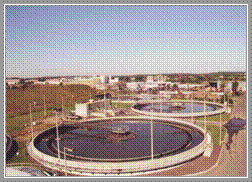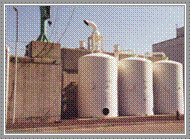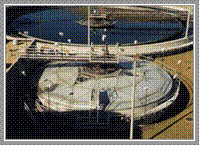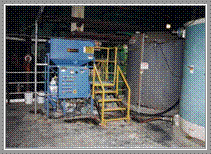Secondary Treatment
 Pollutants dissolved in the wastewater or that would not settle in the primary clarifiers flow on in the wastewater to the Secondary treatment process. Secondary treatment further reduces organic matter (BOD5) through the addition of oxygen to the wastewater which provides an aerobic environment for microorganisms to biologically break down this remaining organic matter. This process increases the percent removals of BOD and TSS to a minimum of 85 percent to meet the standards required in the NPDES discharge permit.
Pollutants dissolved in the wastewater or that would not settle in the primary clarifiers flow on in the wastewater to the Secondary treatment process. Secondary treatment further reduces organic matter (BOD5) through the addition of oxygen to the wastewater which provides an aerobic environment for microorganisms to biologically break down this remaining organic matter. This process increases the percent removals of BOD and TSS to a minimum of 85 percent to meet the standards required in the NPDES discharge permit.
The secondary treatment facilities are comprised of Oxygenation Tanks, Pure Oxygen Generating Plant, Liquid Oxygen Storage Tanks, Secondary Clarifiers, Return Sludge Pumping Station and Splitter Box, Sludge Thickeners, Pumping Station, Sludge and the Dewatering Building Addition.
 The Pure Oxygen Generation System incorporates a pressure swing adsorption (PSA) system oxygen generating system. PSA system is capable of providing 27 tons per day of pure oxygen to the oxygenation system. As a backup to the oxygen generating system, there are two liquid oxygen storage tanks capable of holding 18,000 gallons of liquid oxygen.
The Pure Oxygen Generation System incorporates a pressure swing adsorption (PSA) system oxygen generating system. PSA system is capable of providing 27 tons per day of pure oxygen to the oxygenation system. As a backup to the oxygen generating system, there are two liquid oxygen storage tanks capable of holding 18,000 gallons of liquid oxygen.
The oxygenation system is comprised of three covered oxygenation tanks, mechanical mixing system, and pressure-controlled oxygen feed and oxygen purity-controlled venting system. The primary effluent enters the head end of the tanks where it mixes with return activated sludge which consists of microorganisms "activated" by the organic matter and oxygen. This combination of primary effluent and return sludge forms a mixture known as "Mixed Liquor". This mixed liquor is continuously and thoroughly mixed by the mechanical mixer in each tank. The oxygen gas produced in the PSA system is introduced into the first stage of each tank and then remains in contact with the mixed liquor throughout the oxygenation system.
Once the mixed liquor goes through the complete oxygenation process, it flows to four secondary clarifiers where the biological solids produced during the oxygenation process are allowed to settle and be pumped back to the head of the system. These settled solids being pumped, called return activated sludge, mix with the primary effluent to become mixed liquor. Since the population of microorganisms is growing some microorganisms in the return activated sludge are removed from the system. This solids waste stream is called waste activated sludge and flows to the secondary gravity thickener for Solids Processing. The cleaned wastewater flows over the weir of the secondary clarifier and on to the disinfection (chlorination) process.
The activated sludge process is an aerobic, suspended growth, biological treatment method. It employs the metabolic reactions of microorganisms to produce a high quality effluent by oxidation and conversion of organics to carbon dioxide, water and biosolids (sludge).
Basically the system speeds up nature and supplies oxygen so the aquatic environment will not have to. High concentrations of microorganisms ( compared to a natural aquatic environment ) in the activated sludge use the pollutants in the primary treated wastewater as food and remove the dissolved and nonsettleable pollutants from the wastewater. These pollutants are incorporated into the microorganisms bodies and will then settle in the secondary clarifiers. Oxygen needs to be supplied for the microorganisms to survive and consume the pollutants.
Secondary Clarifiers
The secondary clarifiers are large circular tanks (4 of them) that slow the wastewater stream to allow the well fed microorganisms to settle to the bottom, leaving a clear liquid on top which overflows the tank into a trough and is sent to the chlorine contact tanks for disinfection. The microorganisms that settle are sucked off the bottom by draft tubes (draft tubes vacuum the bottom of the clarifier like a vacuum cleaner ). A portion of the microorganisms are sent back to the aeration reactors to feed again on the incoming wastewater the extras are sent to the gravity thickeners.
Chlorine Contact Chambers
The clear water from the secondary clarifiers goes to the chlorine contact chamber. Chlorine is injected into the water at the beginning of this long tank. The tank is long to give the chlorine enough time to disinfect the water from harmful bacteria. This chlorine is then removed and the resulting effluent is discharged into the ocean. This discharged water is actually cleaner than the ocean water itself.
Gravity Thickeners
 The gravity thickeners take the waste materials collected in the primary and secondary clarifiers and hold them long enough to help them settle to a thicker sludge mixture. This thicker mixture has a polymer ( a charged molecule that helps remove water) added to it as it goes to two high speed centrifuges for further de-watering. These centrifuges remove additional water and the remaining sludge (at 45%) is either burned in the on-site incinerator, processed at another facility or sent to a permitted landfill.
The gravity thickeners take the waste materials collected in the primary and secondary clarifiers and hold them long enough to help them settle to a thicker sludge mixture. This thicker mixture has a polymer ( a charged molecule that helps remove water) added to it as it goes to two high speed centrifuges for further de-watering. These centrifuges remove additional water and the remaining sludge (at 45%) is either burned in the on-site incinerator, processed at another facility or sent to a permitted landfill.
Solids Residual Handling
Dewatering ( the removal of water from sludge ) is a very important process. The more water one removes from sludge the less it costs to burn in an incinerator. In incineration, wet sludges reduce capacity, decrease incinerator "bed" temperature and increase fuel costs.
Gravity thickeners are the first and least expensive method of dewatering sludge. Gravity thickeners hold sludge and allow the sludge to settle down to the bottom and thicken by gravity. Primary clarifier sludge is sent to one thickener and secondary clarifier sludge is sent to the other gravity thickener. Primary sludge mixed only with effluent water for conditioning naturally settles easily in one of the two gravity thickeners. A polymer is added to the secondary sludge before it enters the other gravity thickener to aid in settling. This is because secondary sludge is mostly microorganisms and does not settle easily.
 The primary and secondary sludge are combined immediately before the gravity thickeners. Potassium Permanganate is occasionally added to the conditioned sludge for odor control. The sludge mixture is mixed with a polymer into one of two centrifuges to remove more water. The remaining product is a sludge cake which is approximately twenty to thirty percent (20-30%) solids.
The primary and secondary sludge are combined immediately before the gravity thickeners. Potassium Permanganate is occasionally added to the conditioned sludge for odor control. The sludge mixture is mixed with a polymer into one of two centrifuges to remove more water. The remaining product is a sludge cake which is approximately twenty to thirty percent (20-30%) solids.
The next step in the dewatering process is to squeeze the water out of the sludge with diaphragm filter presses. The thickened sludge from the gravity thickeners are blended together then mixed with a polymer to help coagulate particles together which aids in the dewatering process. This mixture is feed into the centrifuges. The dry sludge "sludge cake" then fall down into a bin where it is pumped with cement type pumps "schwing pumps" to the incinerator.
The separation of a liquid-solids slurry during centrifugal process is similar to the separating process in a gravity thickener. In a centrifuge, however, the applied force is centrifugal rather than gravitational and is usually 500 to 3000 times the force of gravity. Separation is achieved as the result of the applied centrifugal force causing the suspended solids particles to migrate through the suspending liquid, toward or away from the axis of rotation of the centrifuge depending on the difference in densities between the liquid and solids phases. The increased settling velocity imparted by the centrifuge force, as well as the short settling distance, of the particles, are affected by a number of process variables.
The process variables that affect the centrifuge includes; feed rate, rotational speed of the centrifuge, depth of the settling zone (pool depth), chemical used (polymers) and the physiochemical properties of the suspended solids and suspending liquid ( such as particle size and shape, particle density, temperature, and liquid viscosity). The operator must be aware of these variables to optimize the centrifuge performance.

